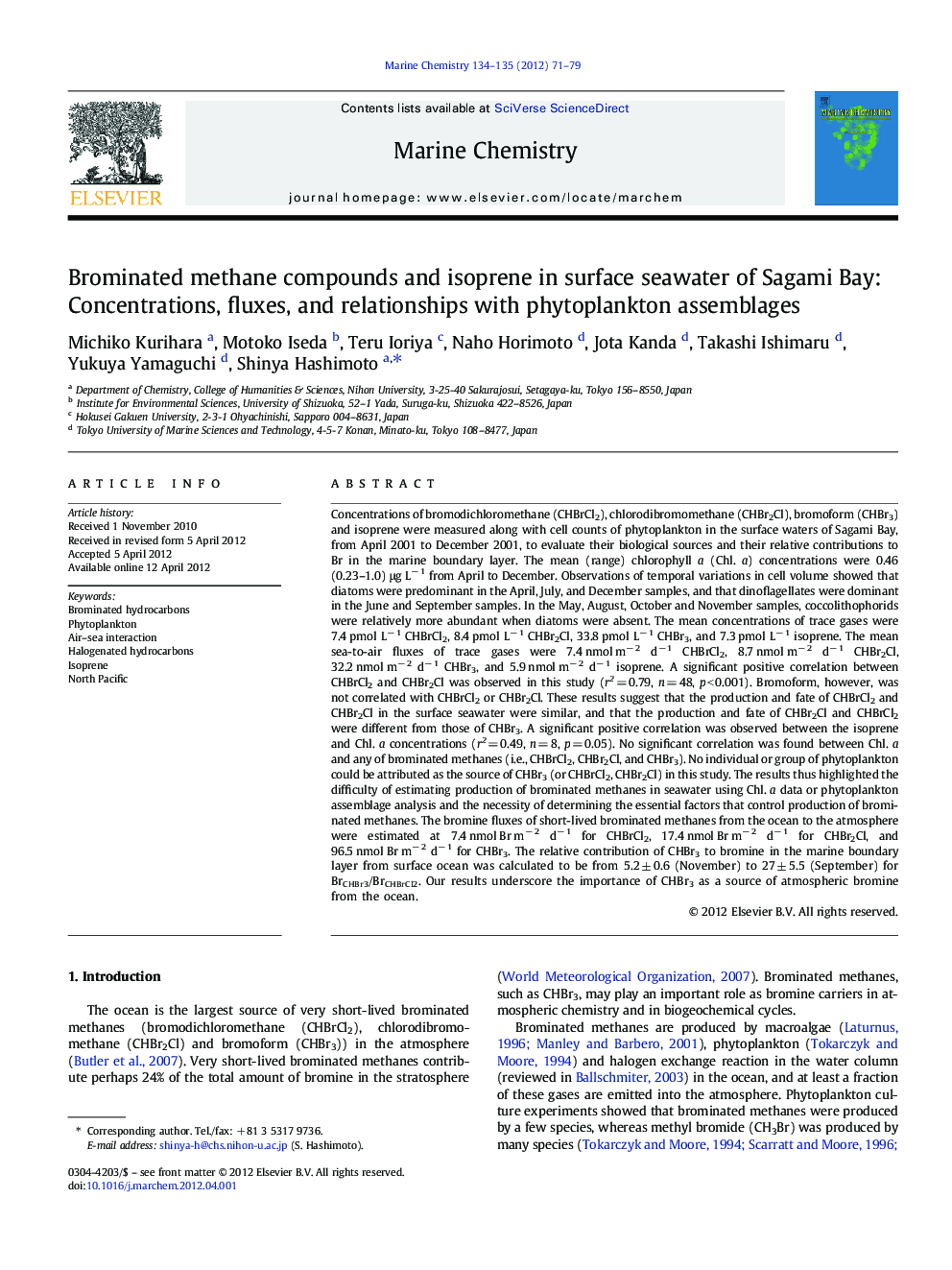| کد مقاله | کد نشریه | سال انتشار | مقاله انگلیسی | نسخه تمام متن |
|---|---|---|---|---|
| 1261679 | 1496693 | 2012 | 9 صفحه PDF | دانلود رایگان |

Concentrations of bromodichloromethane (CHBrCl2), chlorodibromomethane (CHBr2Cl), bromoform (CHBr3) and isoprene were measured along with cell counts of phytoplankton in the surface waters of Sagami Bay, from April 2001 to December 2001, to evaluate their biological sources and their relative contributions to Br in the marine boundary layer. The mean (range) chlorophyll a (Chl. a) concentrations were 0.46 (0.23–1.0) μg L− 1 from April to December. Observations of temporal variations in cell volume showed that diatoms were predominant in the April, July, and December samples, and that dinoflagellates were dominant in the June and September samples. In the May, August, October and November samples, coccolithophorids were relatively more abundant when diatoms were absent. The mean concentrations of trace gases were 7.4 pmol L− 1 CHBrCl2, 8.4 pmol L− 1 CHBr2Cl, 33.8 pmol L− 1 CHBr3, and 7.3 pmol L− 1 isoprene. The mean sea-to-air fluxes of trace gases were 7.4 nmol m− 2 d− 1 CHBrCl2, 8.7 nmol m− 2 d− 1 CHBr2Cl, 32.2 nmol m− 2 d− 1 CHBr3, and 5.9 nmol m− 2 d− 1 isoprene. A significant positive correlation between CHBrCl2 and CHBr2Cl was observed in this study (r2 = 0.79, n = 48, p < 0.001). Bromoform, however, was not correlated with CHBrCl2 or CHBr2Cl. These results suggest that the production and fate of CHBrCl2 and CHBr2Cl in the surface seawater were similar, and that the production and fate of CHBr2Cl and CHBrCl2 were different from those of CHBr3. A significant positive correlation was observed between the isoprene and Chl. a concentrations (r2 = 0.49, n = 8, p = 0.05). No significant correlation was found between Chl. a and any of brominated methanes (i.e., CHBrCl2, CHBr2Cl, and CHBr3). No individual or group of phytoplankton could be attributed as the source of CHBr3 (or CHBrCl2, CHBr2Cl) in this study. The results thus highlighted the difficulty of estimating production of brominated methanes in seawater using Chl. a data or phytoplankton assemblage analysis and the necessity of determining the essential factors that control production of brominated methanes. The bromine fluxes of short-lived brominated methanes from the ocean to the atmosphere were estimated at 7.4 nmol Br m− 2 d− 1 for CHBrCl2, 17.4 nmol Br m− 2 d− 1 for CHBr2Cl, and 96.5 nmol Br m− 2 d− 1 for CHBr3. The relative contribution of CHBr3 to bromine in the marine boundary layer from surface ocean was calculated to be from 5.2 ± 0.6 (November) to 27 ± 5.5 (September) for BrCHBr3/BrCHBrCl2. Our results underscore the importance of CHBr3 as a source of atmospheric bromine from the ocean.
► A positive correlation was observed between CHBrCl2 and CHBr2Cl in surface seawater.
► No source of brominated methanes was identified by phytoplankton assemblage analysis.
► Relative contribution of CHBr3 to Br in marine boundary layer varied over 9 months.
Journal: Marine Chemistry - Volumes 134–135, 20 April 2012, Pages 71–79